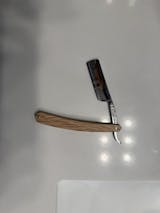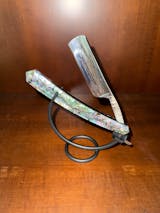The curse of the close shave! Razor burn can ruin even the best grooming day, as any gentleman knows. So, how long does razor burn last if you're one of the 70% of men who get it at least once a month?
What Is Razor Burn And Why Does It Happen?
Razor burn is a skin irritation that occurs when hair follicles become inflamed after shaving. It can cause redness, itching, and a burning sensation and is most commonly seen on the face, legs, and underarms, particularly in areas with sensitive skin and thicker hair.
In some cases, razor burns can lead to razor bumps or ingrown hairs, which can be even more uncomfortable and unsightly.
Understanding the Causes and Symptoms of Razor Burn
Knowing the causes and symptoms of razor burn can help you take steps to prevent it in the future. Some of the primary causes and symptoms of razor burn include:
- Shaving with a dull blade or using too much pressure
- Shaving against the grain of your hair growth
- Dry or sensitive skin that is prone to irritation
- Ingrown hairs that curl back into your skin
- Small red bumps, pimples, or blisters
- Itchiness, burning, or stinging sensations
- Discomfort or pain when touched or rubbed

Razor Burn vs. Razor Bumps: What's the Difference?
Post-shave issues like razor burn and bumps can harm your overall appearance. Understanding the difference between the two is crucial in treating them effectively. Razor burn is caused by skin irritation and appears as a red rash or bumps, while razor bumps are caused by ingrown hairs that curl back into the skin and resemble small pimples. Identifying and treating each condition allows you to maintain a smooth, polished look after every shave.
The Three Stages Of Razor Burn
If you've ever experienced razor burn, you know it can be both painful and unsightly. Fortunately, razor burn follows a predictable pattern of three stages.
- Razor blade pressure and friction cause a tingling or burning sensation that typically only lasts a few hours.
- Redness and inflammation occur, characterized by swollen, irritated skin that can be uncomfortable and itchy for a few days.
- Finally, your skin begins to heal and repair itself, aided by using soothing and moisturizing products while avoiding further irritation from shaving or other products. Over time, redness and inflammation will subside.

Who's At Risk For Razor Burn?
Almost 50% of men experience razor burn, making it one of the most common skin irritations due to shaving. Let's look at some of the key risk factors for razor burn.
Skin Type and Hair Texture
Skin type and hair texture are major risk factors for razor burn, as sensitive skin is more prone to irritation and inflammation, while coarse, curly hair is more difficult to shave and can lead to ingrown hairs.
Shaving Frequency and Technique
Shaving frequency and technique can increase your risk of razor burn. Although there are many myths about shaving too often, frequent shaving can indeed cause more irritation and inflammation, especially if using a dull or dirty razor. Shaving techniques can also contribute to irritation and inflammation, such as using too much pressure, shaving against the grain, or using long strokes.
Considering these factors, razor burn is more likely in people with sensitive skin and coarse, curly hair who shave improperly and don't use aftershave products. Take care of your skin and use the right tools and techniques to avoid razor burn and get a smooth, comfortable shave.
Preventing Razor Burn: Pre-Shave Tips
In today's fast-paced culture, many gentlemen often neglect the fundamental aspects of a proper wet shave routine. However, we fail to realize that taking the time for a pre-shave routine can significantly impact the duration and severity of razor burn or even prevent it altogether.
Aside from using razors with single blades, like safety razors and straight razors, here are the other things you should do to prevent razor burn:

The Dos and Don'ts of Shaving to Prevent Razor Burn
Shaving is an art that requires precision, patience, and proper technique. Here are some dos and don'ts of shaving to help you achieve a smooth and irritation-free shave.
- Do use a sharp razor blade to avoid razor burn and skin irritation.
- Do use shaving cream or gel to lubricate the skin and hair, making shaving easier.
- Don't shave on dry skin, which can cause razor burns, ingrown hairs, and nicks.
- Don't shave against the grain, which can cause irritation, razor burn, and ingrown hairs.
- Do use short, light strokes to avoid cuts and nicks when shaving.
- Do rinse your skin with cool water after shaving to soothe and close your pores.
Best Time of Day to Shave
Shaving in the morning after waking up is the best time to shave because our skin has had time to rest and recover overnight. This makes it less prone to irritation from the shaving process. Additionally, facial hair is at its softest after a night's rest, making it easier to cut and result in a smoother shave to prevent razor burn.
Role of Warm Water and Steam
Using warm water and steam can also prevent razor burns by softening the skin and hair to reduce the effort you need for a close shave, thus minimizing the likelihood of irritation.
For those wondering how long does razor burn last, incorporating warm water and steam into your shave routine can help prevent you from having razor burn in the first place. So, take the time to indulge in a warm shower or apply a warm towel to your face before shaving for a smoother and more comfortable experience.
Benefits of Exfoliating
By removing dead skin and revealing the hair follicles, exfoliation can help prevent razor burns and improve the quality of your shave. Be careful not to over-exfoliate, leading to redness and further skin damage. Instead, limit your exfoliation to once or twice weekly.

Using the Right Amount of Pressure
Use the right amount of pressure to reduce shaving stress, or let your razor do the work to avoid microscopic wounds that lead to razor burn. If your skin is clean and your blades are sharp, your light touch will give you a close, irritation-free shave. It will be also better to map your face to avoid going heavy handed while going on the wrong shaving direction.
Ingredients to Look for in Shaving Creams and Gels
One of the ways to prevent razor burn is by using the right shaving cream, shaving soap, or shaving gel. Opt for items with ingredients that can reduce inflammation and irritation caused by shaving and achieve a smoother, more comfortable shave.
Here are some good and bad ingredients to look out for when choosing a shaving cream or gel to prevent razor burn:
Good Ingredients:
- Aloe Vera: Soothes and reduces inflammation and irritation caused by shaving.
- Tea Tree Oil: Prevents razor bumps and ingrown hairs with antibacterial properties.
- Glycerin: Attracts and retains moisture in the skin, reducing the risk of razor burn.
- Vitamin E: Protects and nourishes the skin to reduce inflammation and prevent razor burn.
- Coconut Oil: Moisturizes and lubricates the skin to reduce the risk of razor burn.
Bad Ingredients:
- Alcohol: Dries out the skin and increases susceptibility to irritation and razor burn.
- Fragrance: Harsh synthetic fragrances increase the risk of irritation and razor burn.
- Menthol: Can irritate some people, especially those with sensitive skin.
- SLS (Sodium Lauryl Sulfate): Harsh detergent that strips the skin of natural oils, making it more susceptible to irritation and razor burn.
- Parabens: Preservatives that may contribute to skin sensitivity and razor burn.

Treating Razor Burn
Even the best-laid shaving plans fail. Don't panic and question your shaving skills when the burning sensation starts. Normal razor burn lasts 2-3 days or up to a week for severe cases. You can treat it with home remedies, such as aloe vera, honey, and oatmeal, or use over-the-counter and aftershave products. However, if symptoms persist longer than a week and is accompanied by other irritations, your razor burn may be a more serious condition that requires medical attention.
Home Remedies and DIY Treatments for Razor Burn
Natural ingredients such as aloe vera, tea tree oil, and coconut oil can effectively reduce inflammation and promote healing. Aloe vera has anti-inflammatory properties, while tea tree oil has antibacterial properties that can prevent infection. Coconut oil can moisturize the skin and reduce redness. You can also try DIY treatments to provide relief such as oatmeal baths and honey masks.
Over-the-Counter Treatments for Razor Burn
Over-the-counter treatments can effectively treat razor burns if you prefer a quick and easy solution. Look for products that contain active ingredients, such as hydrocortisone, salicylic acid, or benzoyl peroxide. These ingredients can help reduce inflammation, unclog pores, and prevent infection.
Active Ingredients in Razor Burn Treatments
Hydrocortisone is a common ingredient in razor burn treatments that helps reduce inflammation and soothe the skin. Salicylic acid can help unclog pores and prevent ingrown hairs, while benzoyl peroxide can kill bacteria and prevent infection. Look for products that contain these active ingredients to treat a razor burn effectively.
Dangers of Using Harsh Chemicals
While over-the-counter treatments can be effective, it's important to be cautious when using products that contain harsh chemicals. Alcohol, fragrance, and menthol can worsen razor burn and cause further irritation. So, read labels to avoid products that contain these harsh chemicals.
Aftershave Products for Post-Shave Relief
After shaving, it's important to moisturize the skin to prevent razor burn and promote healing. Look for products specifically designed for post-shave relief that contain ingredients such as shea butter, cocoa butter, or jojoba oil. These ingredients can moisturize the skin and reduce redness and irritation.
The Key Takeaways
Razor burn is a common post-shave irritation due to blade movement against the skin. Mild cases can last from a few days to a week, while severe cases can last even longer. Your shaving routine, genetics, skin condition, and medication can all influence how long razor burn lasts.
Those who follow proper wet shaving routines with a sharp, clean razor and have normal, healthy skin are less likely to suffer from severe razor burns. Regardless of the severity of your razor burn, taking care of your skin and using the right remedies can ensure a smooth, comfortable shave.















